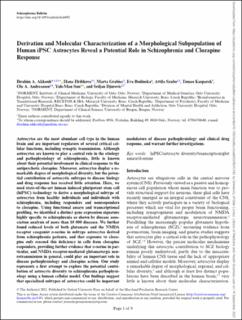| dc.description.abstract | Astrocytes are the most abundant cell type in the human brain and are important regulators of several critical cellular functions, including synaptic transmission. Although astrocytes are known to play a central role in the etiology and pathophysiology of schizophrenia, little is known about their potential involvement in clinical response to the antipsychotic clozapine. Moreover, astrocytes display a remarkable degree of morphological diversity, but the potential contribution of astrocytic subtypes to disease biology and drug response has received little attention. Here, we used state-of-the-art human induced pluripotent stem cell (hiPSC) technology to derive a morphological subtype of astrocytes from healthy individuals and individuals with schizophrenia, including responders and nonresponders to clozapine. Using functional assays and transcriptional profiling, we identified a distinct gene expression signature highly specific to schizophrenia as shown by disease association analysis of more than 10 000 diseases. We further found reduced levels of both glutamate and the NMDA receptor coagonist D-serine in subtype astrocytes derived from schizophrenia patients, and that exposure to clozapine only rescued this deficiency in cells from clozapine responders, providing further evidence that D-serine in particular, and NMDA receptor-mediated glutamatergic neurotransmission in general, could play an important role in disease pathophysiology and clozapine action. Our study represents a first attempt to explore the potential contribution of astrocyte diversity to schizophrenia pathophysiology using a human cellular model. Our findings suggest that specialized subtypes of astrocytes could be important modulators of disease pathophysiology and clinical drug response, and warrant further investigations. | en_US |

